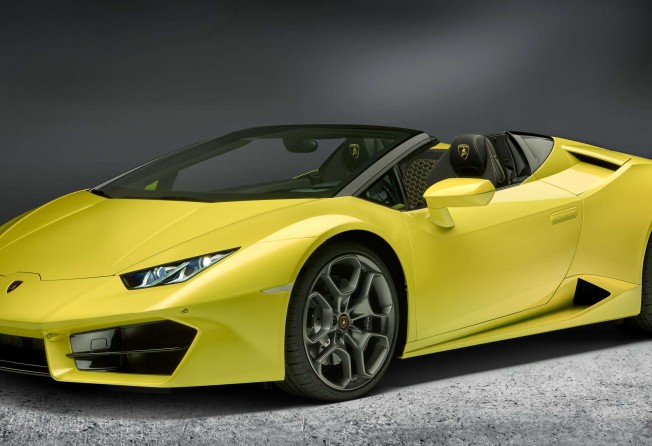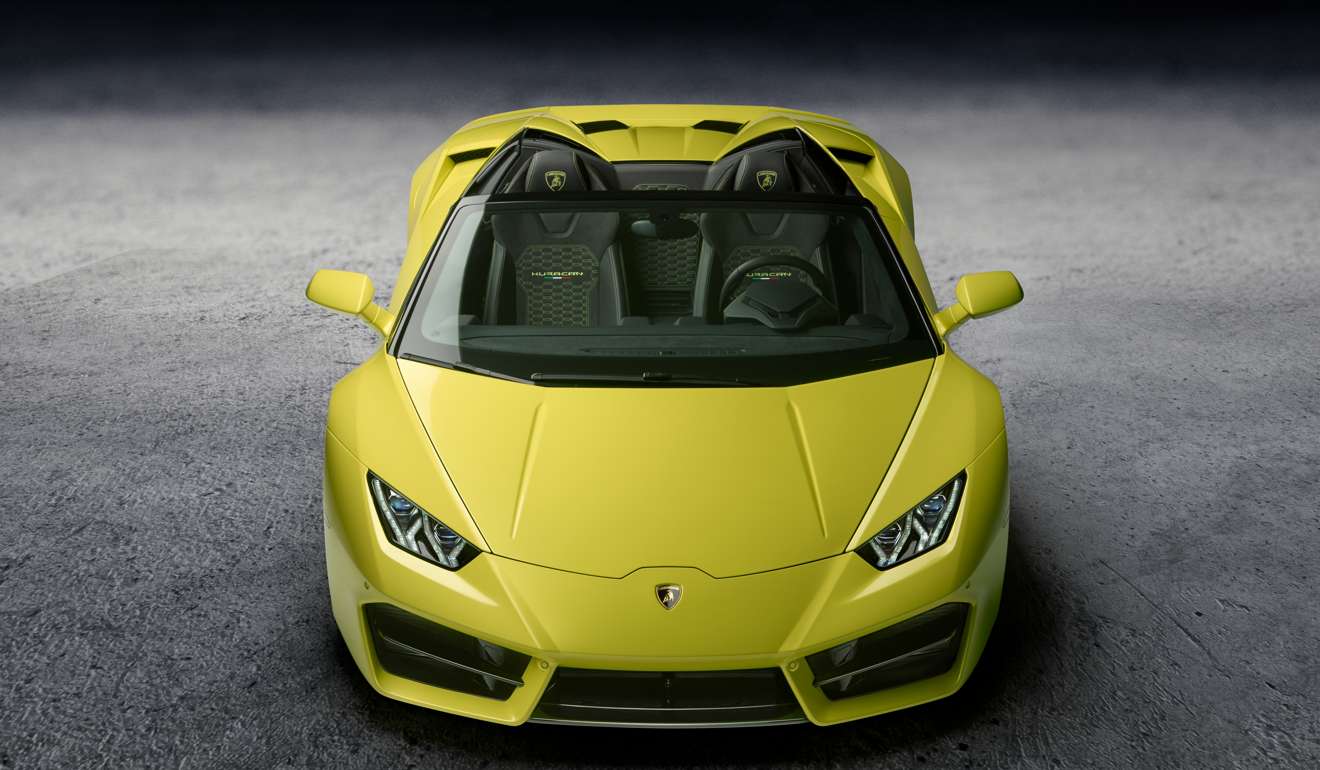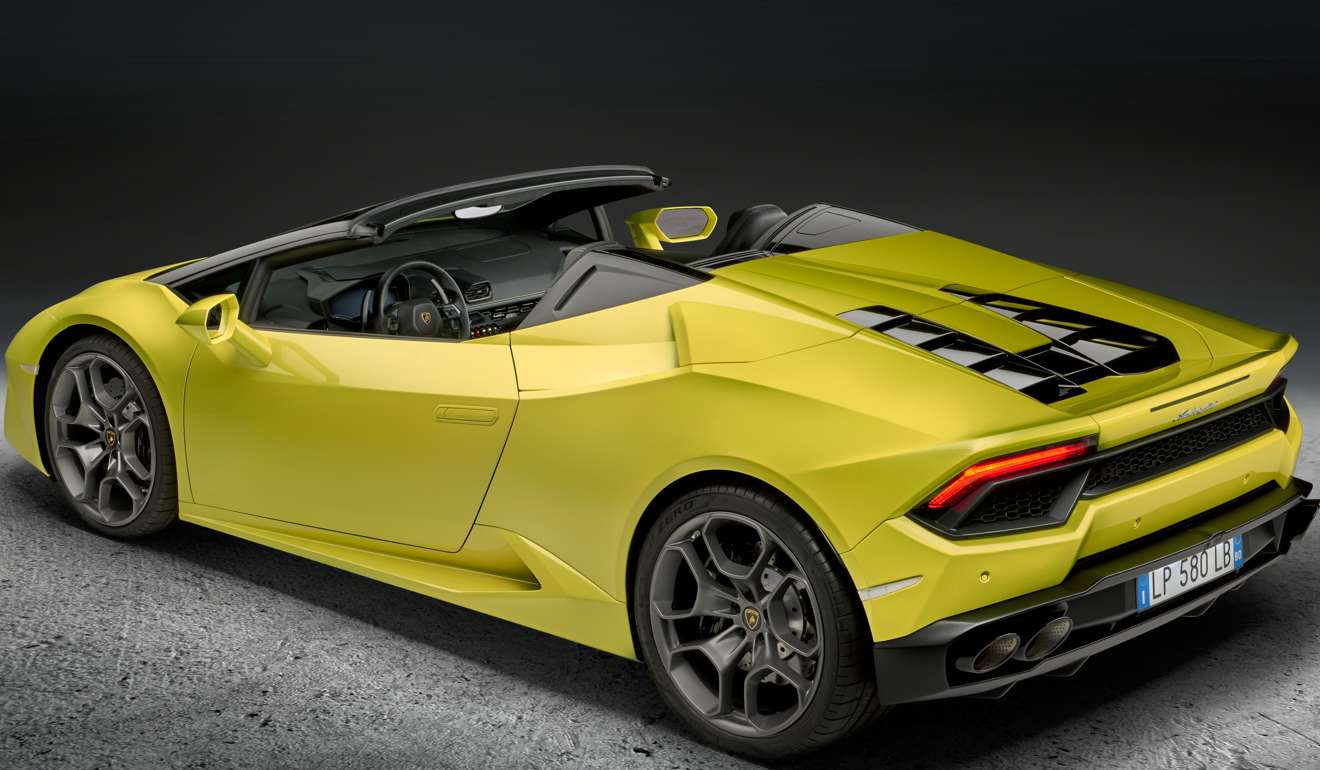
Coming soon: How the Lamborghini Huracán Rear-Wheel-Drive Spyder can rev a Fast and Furious lifestyle
Exciting V10 supercar expected to challenge Ferrari and McLaren in Hong Kong by autumn

The 2017 Lamborghini Huracán Rear-Wheel-Drive Spyder and its predecessor, an all-wheel-drive version, are virtually identical. Aside from a subtle widening of the front air intakes and specially contoured aluminium brakes to increase downforce, you’d be hard-pressed to pick the new one out in a line-up.
Which raises the question: Why spend US$20,000 more on the rear-wheel-drive version, especially since it’s more squirrely to drive? My answer: exactly.
If you are in the market for a Lamborghini, you are in the market for something that feels radical when you drive it – far different from any other car on the market today. And probably you are keen to signal just how little the extra expense impacts your bank account.
The 2017 Lamborghini Huracán RWD Spyder (alias the Huracán LP 580-2 Spyder) is expected in Hong Kong at the end of the late summer to autumn of this year. Local dealer Lamborghini Hong Kong can’t name a price this week, but says the Huracan RWD Coupe is from HK$3.68 million.

However, Francesco Scardaoni, managing director of Automobili Lamborghini Greater China, says the rear-wheel-drive range appeals to drivers “desiring a more intense driving experience, or those who currently drive other rear-wheel-drive marques and aspire to drive a Lamborghini”.
The rear-wheel-drives are “the purest expression of a Lamborghini to date, with class-leading technological refinements making fun the essence of driving”, he tells the South China Morning Post.
The rear-wheel-drive’s weight distribution has changed, adds Scardaoni, an Aventador enthusiast.
“We now have 40 per cent on the front axle, and 60 per cent on the rear axle,” he says. “It is very suitable for city driving because the steering is light and the set up allows more power over steering behaviour. But of course, the car is able to give you the confidence of a really solid front axle.”
As a result, this Spyder version embodies what a modern Lamborghini is and should be – visually arresting, massively powerful, a little dangerous, and uniquely exhilarating to drive. Without apologising for any of it.
Its closest competitors are the Ferrari 488 GTB and the McLaren 675LT. They both use rear wheel drive, cost well over US$200,000 and look unmistakable. When you see a McLaren or a Ferrari, you know it.

The Huracán RWD Spyder looks far odder on the road, with its pressed-flat roofline, chiselled rear haunches, and gaping air vents. When you drive it, you will get far more love and hate than if you drive the McLaren or the Ferrari. (I should know. I have driven – and been cat-called, jeered, cheered, and judged in – all three.)
Visually, it is truly a novelty, especially if you buy the convertible version, rather than the Huracán coupe. It completes the whole unapologetically brash, top-dog image one wants when buying into this brand.
The thick rag top deploys in 17 seconds, even with the car moving up to about 50km/h. How better to hear that agitated 580-horsepower, V10 engine and make sure everyone knows you are the driver lucky (and ballsy) enough to be behind the wheel? This is pure Lamborghini braggadocio on a level you don’t get with a hardtop car.
(A word to the wise: You must embrace that braggadocio to drive a Lamborghini, but do pare down your own look before getting behind the wheel. This whip is crazy enough without a loud wardrobe making you look ridiculous). A similar unhinged element lurks under the bonnet. Where most luxury cars are exercises in personal style, rather than feeling fundamentally unique when you drive them, this Lambo drives as if it came from a different universe.
If driving the McLaren is precise like brain surgery, and driving the Ferrari is beautiful like an opera, driving the Lamborghini is like joining the cast of Fast and the Furious. It is unpredictable and opinionated. It will fishtail and get away from you on the back-end if you don’t pay attention. Credit the unnerving combination of Lamborghini’s seven-speed, dual-clutch, double-wishbone, independent suspension and super-stiff, carbon-fibre, hybrid chassis – finally let fully off-leash with that new rear wheel drive.

It is on a whole other level than the standard offerings from Mercedes and BMW and Audi, but it is also wildly different in feel from Ferrari and McLaren, too.
There are three drive modes: Corsa for racing, Strada for city driving and maximum grip, and Sport for a delicious oversteer attainable with just a twitch of the wheel and accelerator pedal. In addition, Adaptive Network Intelligent Management technology adjusts the vehicle’s behaviour based on the driving style of the person inside. There is also electronic stability control and optional Lamborghini Dynamic Steering that varies the steering ratio to maintain the ideal steering response in all road conditions.
These things allow this Lamborghini to excel at high speeds. Zero to 100km/h takes about 3.4 seconds, and its top speed is about 320km/h.
They also help achieve a more elusive standard for supercars: being tolerable to drive under low speeds. It is one thing to be able to get a bunch of power and thrust calibrated for insane acceleration. Plenty of cars and motorcycles, for that matter, don’t come alive properly until they pass a certain threshold. They are meant to live at that speed. But that engineering also makes the cars beastly to drive under more mundane conditions.
I drove the Huracán RWD Spyder for a week in Los Angeles (which means a lifetime in traffic). I took it to Santa Monica and Venice and West Hollywood and Topanga Canyon and Silver Lake. Yes, the pitiful side and rear visibility and the (lack of) clearance, even with the button that lifts the front up an inch, are enough to cause an ulcer. But the car doesn’t get heated and rumbly sitting in gridlocked traffic, as the Aventador does.
The steering is so light you can do it with a finger, and the turning radius is an indecisive driver’s dream. These small benefits mean the RWD Spyder is infinitely more livable on a daily basis than its more aggressive brother.
The car also uses a system that will deactivate cylinders on that normally aspirated, dry-sump V10 engine, cutting ignition to one five-cylinder bank when full strength is not needed. That helps achieve a combined 19-miles-per-gallon (12.37 litres per 100km) efficiency, which beats the Huracán coupe (17mpg / 13.8l/100km) and Aventador Roadster (12mpg/ 19.6l/100km). No one buys a Lamborghini to save petrol – but if you are buying one anyway, this is the one that will require fewer pit stops.
You have got better things to do.
Additional reporting by William Wadsworth